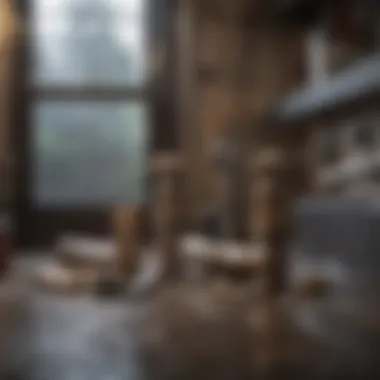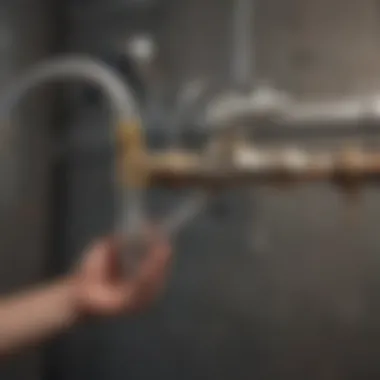Expert Techniques for Clearing Plumbing Blockages


Intro
Understanding the intricacies of plumbing blockages is crucial for maintaining a functional home. Homeowners frequently face a variety of plumbing issues, with blockages being one of the most common. This article will explore expert techniques that can help effectively clear these obstructions. We will look at various types of plumbing blockages, detailed diagnosis methods, and the essential tools required to overcome them. We will also introduce preventative measures to avoid these issues in the future.
The aim is to equip homeowners with practical knowledge, enabling informed decisions in plumbing care. By grasping these expert techniques, the uneasiness associated with plumbing malfunctions can be significantly reduced, which is essential for a comfortable living environment.
Understanding Plumbing Blockages
Understanding plumbing blockages is essential for homeowners and tenants alike. It can save time, reduce costs, and prevent damage to your property. Plumbing blockages occur due to various reasons, and recognizing these can lead to timely solutions. An effective approach to handling these situations also enhances the longevity of plumbing systems.
Definition of Plumbing Blockages
Plumbing blockages refer to any obstruction in pipes or drains that impedes the flow of water. This can occur in residential or commercial properties. It is crucial to note that blockages can develop over time, often unnoticed, until significant issues arise. Common signs include slow drainage or unpleasant odors.
Common Causes
Recognizing the common causes of plumbing blockages aids in prevention and resolution. Here are three primary contributors:
Grease buildup
Grease buildup happens when oils and fats accumulate over time in pipes. This substance hardens as it cools, creating significant blockages. The key characteristic of grease buildup is its slippery nature, which makes it easy to overlook initially. However, it is a prevalent issue in many kitchens. The advantages of knowing about this cause include the ability to take proactive measures, such as regular cleaning and avoiding pouring grease down the drain.
Foreign objects
Foreign objects typically include items like hair, food scraps, and hygiene products that end up in drains. A key characteristic of foreign objects is their unpredictable nature—they often get washed away unexpectedly, leading to sudden blockages. Understanding this cause benefits readers by highlighting the importance of proper disposal methods. The unique feature of foreign objects is that they can often be easily removed, though they may cause temporary disruptions in drainage.
Tree root intrusion
Tree root intrusion occurs when the roots of trees or shrubs penetrate underground pipes. This is particularly prevalent in older neighborhoods where pipes may be clay or other porous materials. A key characteristic of tree root intrusion is its gradual nature; it may take time for roots to grow large enough to cause significant blockage. Recognizing this issue allows homeowners to address landscaping and maintain the integrity of plumbing systems. The unique feature is that while prevention can be challenging, effective management can limit damage over time.
Signs of a Blocked Drain
Identifying the early signs of a blocked drain is crucial for preventing more serious plumbing issues down the line. Recognizing these indicators can help homeowners take timely action, thus minimizing potential damage and repair costs. Often, plumbing blockages can lead to more extensive problems, such as water damage or even structural issues. Therefore, understanding these signs will empower homeowners to maintain their plumbing systems effectively.
Slow drainage
Slow drainage is one of the most noticeable signs of a blocked drain. When water takes longer than usual to flow down the sink, shower, or toilet, it's an indication that there is some obstruction in the piping. Homeowners should pay attention to how quickly or slowly water drains in various fixtures. A single slow drain may not be alarming, but when multiple drains exhibit this issue, it often points to a more significant blockage in the main stack or a shared pipe.
Some common causes for slow drainage include:
- Grease buildup which can coat the insides of pipes.
- Hair and soap residue collecting in shower drains.
- Debris or foreign objects lodged in the plumbing system.
To address slow drainage, a homeowner can start with a simple solution like boiling water or a plunger, depending on the severity of the blockage. If these methods do not resolve the issue, it may require more specialized tools, like a plumber's snake or chemical cleaners, to clear the drain more effectively.
Unpleasant odors
Another critical sign of a blocked drain is the presence of unpleasant odors. Foul smells emanating from sinks, bathrooms, or basements can indicate stagnant water that is unable to flow freely due to a blockage. These odors are often a result of waste accumulation and decay, which contributes to an unhealthy living environment.
Common sources of these odors include:
- Organic matter decomposing in pipes.
- Grease that has not been flushed away properly.


Homeowners should take note of any unusual smells and investigate their source promptly. Ignoring such smells might not only lead to discomfort but may also signal a more serious plumbing problem.
To mitigate odors, homeowners can use natural solutions such as a mixture of vinegar and baking soda. This combination can help break down grease and clear away small blockages, thus improving the overall scent of the affected area.
Gurgling sounds
Gurgling sounds coming from drains are often an alarming sign of an impending blockage. These noises typically occur when air is trapped in the plumbing system. As water struggles to get past the blockage, it pushes air upward, resulting in these distinctive gurgling sounds. Homeowners should be cautious if they start to notice these noises regularly, as they might indicate that a blockage is forming or has formed, particularly in the vents or waste system.
Key things to consider about gurgling sounds:
- Consistency: Infrequent gurgling might not be a concern, but persistent noises are worth investigating.
- Multiple fixtures: If gurgling can be heard from several drains, the issue is likely more widespread within the plumbing network.
If such sounds persist, it's advisable to consult with a plumbing professional. They can perform a thorough examination to determine the location and extent of the blockage, using tools such as cameras to assess the internal condition of pipes.
Taking action when these signs appear can save homeowners significant time and expenses in the future.
Initial Assessment of the Problem
Understanding the characteristics of a plumbing blockage is crucial to effective resolution. The initial assessment serves as the foundation for any restoration efforts. It is this stage where homeowners must ascertain the nature and extent of the blockage, significantly influencing the methods used to tackle the issue.
An accurate assessment allows for the identification of the following:
- Type of blockage: Knowing whether it's caused by grease, foreign objects, or tree roots helps in selecting the right approach.
- Location of blockage: Identifying whether the blockage is in a sink, toilet, or mainline is vital. Each scenario may demand different techniques and tools.
- Severity of blockage: Determining how severely the drainage is affected can guide decisions on whether to use simple tools or call professionals.
The benefits of a thorough assessment cannot be overstated. It enables homeowners to act swiftly, potentially preventing further damage to the plumbing system. Additionally, it reduces the risk of using inappropriate methods that could exacerbate the problem. Overall, engaging in a careful initial assessment streamlines the process and enhances the effectiveness of subsequent actions.
Visual Inspection
Visual inspection involves looking for any signs that may indicate blockages. This can include observing slow draining water, gurgling noises, or unexpected puddles around plumbing fixtures. Assessing visible areas, such as sinks and toilets, provides initial clues about where the obstruction may lie.
In addition to looking for direct signs of blockage, inspecting for leaks or corrosion can also reveal underlying issues that contribute to drainage problems. Homeowners can utilize tools like a flashlight for better visibility, ensuring no detail is overlooked. Keeping an eye out for uncommon odors can also alert one to a blockage near the sewage line.
A visual inspection is a cost-effective way to gather immediate information before moving on to more invasive procedures or equipment. Taking time for this step can save both time and expense down the line.
Using a Plunger
The plunger is a fundamental yet effective tool for clearing simple blockages. It works by creating suction and pressure. To utilize it properly, ensure that the plunger's rubber cup seals well against the drain. This is critical for achieving effective results.
Begin by filling the sink or tub with enough water to cover the cup. Next, place the plunger over the drain and push it down gently before pulling it back sharply. Repeating this action can help dislodge any minor obstructions. It's essential to maintain a steady rhythm while plunging, as a consistent force often proves more effective.
In some cases, it may take several attempts to achieve success. If the blockage does not clear, it may be necessary to consider other methods or tools. While plungers are excellent for surface-level issues, they might not suffice for deeper or more complex blockages.
Mechanical Tools for Clearing Blockages
Understanding the role of mechanical tools in clearing plumbing blockages is crucial for effectively addressing plumbing issues. These tools offer targeted solutions that can yield immediate results, often outperforming chemical remedies when it comes to severe clogs. They depend on physical interaction to remove or break down the materials causing the blockage. Homeowners often face challenges with slow drains or obstructions, prompting the need for reliable tools. Each tool serves unique purposes, supporting different scenarios based on the nature and severity of the blockage. With knowledge of these tools, anyone can enhance their plumbing toolkit, leading to more efficient home maintenance.
Plumber's Snake
A plumber's snake, also known as a drain auger, is a flexible auger used to dislodge material blocking pipes. It typically consists of a long, coiled metal wire that twists through the pipe to grab, break up, or push through obstructions. One key advantage of using a plumber’s snake is its ability to reach deep into drains where many other tools cannot. It is especially effective against tough blockages such as tree roots or significant grease buildup. Sometimes, simply using a snake can resolve an issue without further intervention.
It is critical to know how to properly use a plumber's snake. Begin by pushing the snake into the drain until resistance is felt. Then, turning the handle allows the coil to spin and penetrate the clog. Repeat the process until the flow of water improves. Caution is necessary to avoid damaging pipes or plumbing fixtures. Regular practice with this tool can ensure effective and safe usage when emergencies arise.
Hydro Jetting


Hydro jetting is a high-pressure cleaning method using water jets to remove blockages. This process utilizes specialized equipment capable of producing water pressure that can exceed 4,000 psi. It not only clears blockages but also cleans the walls of pipes, reducing buildup for a long-term solution. Hydro jetting is ideal for significant clogs that may resist other forms of clearing. This tool is often deployed in commercial settings or homes facing recurring issues due to accumulations over time.
When considering hydro jetting, professionals typically assess the pipe condition first, as older or fragile pipes may be at risk of damage under high pressure. While hydro jetting can be incredibly effective, it requires expertise to operate the machinery safely. Therefore, calling a professional is often the best route for those interested in utilizing hydro jetting for their plumbing problems.
Drain Augers
Drain augers are similar to plumber's snakes but serve specific applications, particularly in clearing wider pipes. Augers can come in many forms, designed for different sizes and types of drains. A critical feature is their ability to use a corkscrew mechanism to break through clogs effectively. Some drain augers are motorized, greatly enhancing the force applied and, consequently, their effectiveness.
Using a drain auger involves inserting the head into the drain and cranking the handle to push the auger into the blockage. Once it is lodged, continue to rotate to break apart the clog. This tool is particularly favorable for homeowners dealing with tough substances like hair or tissue that commonly cause bathroom drains to clog. Regular maintenance with a drain auger can help prevent severe blockages from developing into more significant plumbing issues.
"Mechanical tools such as plumber's snakes, hydro jetting, and drain augers are indispensable in maintaining the integrity and function of household plumbing systems."
Chemical Solutions for Blockages
Chemical solutions for blockages play a significant role in plumbing maintenance. They can provide a fast and effective method to clear stubborn pipes without the need for more invasive mechanical tools. These solutions can break down or dissolve various types of obstructions, including hair, grease, and food particles.
However, there are benefits and downsides to using chemical cleaners. On the positive side, they tend to be easy to use and can often work quickly. For homeowners looking for immediate results, this can be appealing. Nevertheless, it is crucial to consider the potential harm these chemicals may cause to the environment and to plumbing systems over time. Overuse of corrosive substances can lead to pipe deterioration, impacting the longevity of the plumbing.
Therefore, one must balance the immediate effectiveness of chemical solutions with their long-term consequences. This approach calls for careful consideration when selecting types of chemical cleaners and understanding how to use them safely.
Commercial Drain Cleaners
Commercial drain cleaners are readily available options for tackling plumbing blockages. They often contain strong chemicals and act quickly to dissolve clogs. Many products are specifically designed for distinct materials, such as acid-based cleaners for tough clogs involving mineral buildup.
Yet, the use of these cleaners comes with risks. Many contain harsh substances like sodium hydroxide or sulfuric acid, which can be dangerous if mishandled. Users should strictly follow instructions on packaging to ensure safety. It is also smart to protect skin and eyes when using these products. Additionally, their effectiveness can vary, and often they do not work for all types of clogs, such as tree roots in sewer pipes. Overuse can also lead to environmental problems, which is a growing concern for many homeowners today.
Homemade Remedies
For those who prefer natural alternatives to store-bought drain cleaners, homemade remedies can be effective and safer. Simple household ingredients can help dissolve blockages without harmful chemicals. Two commonly used options are baking soda and vinegar as well as salt and hot water.
Baking soda and vinegar
Baking soda and vinegar is a popular, non-toxic solution that can tackle minor plumbing issues effectively. This combination works well in neutralizing odors and breaking down certain types of clogs. The reaction produces carbon dioxide, which can help lift debris away from the pipes.
The key characteristic of this remedy is its safety. Unlike chemical cleaners, baking soda and vinegar do not pose harm to the plumbing system or the environment when used appropriately. However, the effectiveness is generally limited to minor blockages, such as grease or soap residue. For tougher clogs, this method might not deliver the results desired, but it can be a beneficial preventative measure to maintain clearer drains.
Salt and hot water
Salt and hot water is another effective and eco-friendly combination to maintain plumbing systems. By pouring salt down the drain and following it with hot water, you can help break down grease, foods, and other substances that have built up in the pipes. The heat from the water helps dissolve the salt, creating a solution that can wash away accumulated debris.
The advantages of using this method are clear. It is inexpensive and readily available in most households, making it an accessible tool for anyone looking to manage minor clogs. However, it is worth noting that while this method can help with grease buildup, it may not be effective against more significant blockages, such as those caused by foreign objects.
Preventative Measures to Avoid Future Blockages
Preventative measures are critical in maintaining a functional plumbing system in your home. By adopting proactive strategies, homeowners can significantly reduce the frequency and severity of plumbing blockages, saving both time and money in the long run. Effective maintenance and proper disposal methods not only ensure smooth drainage but also enhance the overall lifespan of your plumbing infrastructure.
Regular Maintenance
Regular maintenance is an essential practice for homeowners. By keeping a routine check on your plumbing fixtures, you can identify potential issues before they turn into major blockages. This includes periodic inspections of the drains, cleaning the pipes, and checking for signs of wear.
It is advisable to schedule a professional inspection at least once a year. Experts can identify hidden problems such as corrosion or minor blockages. Additionally, performing minor cleaning tasks like flushing the system with hot water can help prevent the buildup of materials such as grease or hair.


Proper Disposal Methods
Understanding proper disposal methods is vital to avoid future plumbing issues. The way you dispose of waste directly impacts the condition of your plumbing.
Grease disposal
Grease is a common culprit in plumbing blockages. Many people tend to pour grease down the sink after cooking. This practice can lead to fat buildup within the pipes, resulting in reduced water flow and ultimately a clog.
A beneficial alternative is to allow grease to cool and then scrape it into a container for disposal in the trash. This method does not contribute to blockages and helps maintain clear pipes. It's also environmentally friendly as it prevents harm to the sewage system.
Avoiding flushing foreign items
Flushing foreign items down the toilet may seem inconsequential, but it can lead to significant plumbing issues. Items such as wipes, sanitary products, and even hair can cause major blockages.
The key characteristic of adhering to proper flushing guidelines is the direct benefit it brings to the plumbing system. Educating everyone in your household about what can and cannot be flushed down the toilet is essential. Ensuring that this rule is followed can reduce plumbing repairs and enhance the functionality of your drains.
When to Call a Professional Plumber
In situations involving plumbing blockages, the temptation for homeowners is often to resolve the issue independently. However, there are specific scenarios when the expertise of a professional plumber becomes crucial. This section emphasizes the importance of recognizing these circumstances. Understanding when to call a professional plumber can not only save time but also prevent further damage to your plumbing system.
Inaccessible Blockages
Certain blockages may be located in parts of the plumbing that are not easily accessible. This includes pipes buried underground or those hidden behind walls. Accessing these areas typically requires specialized tools and equipment that are not common in an average household. For instance, a professional plumber often employs advanced tools such as video inspection cameras to locate the blockage without causing unnecessary damage to the property.
If the blockage is dominated by tree roots or structural issues, professional involvement is essential. Tree roots can penetrate pipes, leading to significant damage if not handled properly. In such cases, a plumber can provide insights into repair options. Moreover, inaccessible blockages can escalate rapidly, leading to more severe plumbing issues and higher repair costs if they linger too long.
Remember: Attempting to reach or clear an inaccessible blockage without the right knowledge can exacerbate the issue, resulting in damage that could lead to costly repairs.
Repeated Blockages
Experiencing recurring blockages in a plumbing system is a sign that something more significant may be wrong. If you find that a drain continues to clog despite your attempts to clear it, this is a red flag. It often suggests underlying issues such as drainage system problems, degraded pipes, or a compromised sewer line.
In these instances, calling a professional plumber can be beneficial. They possess the expertise to assess the entire plumbing system and diagnose chronic issues. This may involve conducting tests such as hydrostatic testing to determine if there are leaks or weak points in the plumbing infrastructure.
Ignoring repeated blockages can lead to serious problems, such as increased pressure on the system and potential leaks that could damage your property. As a rule of thumb, if you must clear the same blockage more than two times a year, seeking professional help is advisable.
In summary, while it is commendable to address minor plumbing issues on your own, certain scenarios clearly warrant the expertise of a professional plumber. This not only ensures effective resolution but also safeguards the condition of your plumbing infrastructure.
Environmental Considerations
Addressing plumbing blockages is not only about maintaining functionality in a home's plumbing system; it also carries significant environmental implications. Recognizing the ecological impacts of various methods can guide homeowners toward more sustainable practices, ultimately resulting in benefits for both their plumbing systems and the environment.
Impact of Chemical Cleaners
Chemical drain cleaners are commonly used for their efficiency in dissolving clogs. However, these substances often contain harsh chemicals such as sodium hydroxide and sulfuric acid. While they can clear blockages effectively, they pose serious risks to both human health and the environment.
- Toxicity: Many chemical cleaners are toxic. If mishandled, they can cause severe burns on skin and pose inhalation hazards.
- Water Pollution: When these chemicals enter the drainage system, they can contaminate water supply sources and harm aquatic ecosystems. This results in broader environmental damage.
- Pipe Damage: Frequent use of strong chemical agents can corrode plumbing surfaces, leading to further blockages or leaks. Over time, this can necessitate expensive repairs or replacements.
Due to these factors, it is essential to consider alternative methods for clearing blockages, prioritizing those that minimize chemical use.
Sustainable Plumbing Practices
To foster better environmental outcomes, homeowners should adopt sustainable plumbing practices. This does not only address immediate issues but also contributes to long-term benefits for individuals and the larger ecosystem.
- Preventative Maintenance: Regular inspections and maintenance can prevent the buildup of debris before it becomes a problem. This includes using sink strainers to catch food particles and hair before they enter pipes.
- Natural Solutions: Implementing eco-friendly methods, such as baking soda and vinegar, can effectively tackle minor blockages without introducing harmful chemicals into the system. This mixture is a safer alternative that can clear drains effectively.
- Educate and Dispose Responsibly: Teaching household members about proper disposal methods is vital. Avoiding flushing inappropriate items or pouring grease down the sink can significantly reduce the risk of blockages.
"Sustainable practices are not just a trend; they are necessary for the health of our planet, especially in daily activities like plumbing."
- Consideration of Landscaping: When planning outdoor areas, consider the impact of roots. Choosing appropriate plants can mitigate the risk of roots invading plumbing systems.







